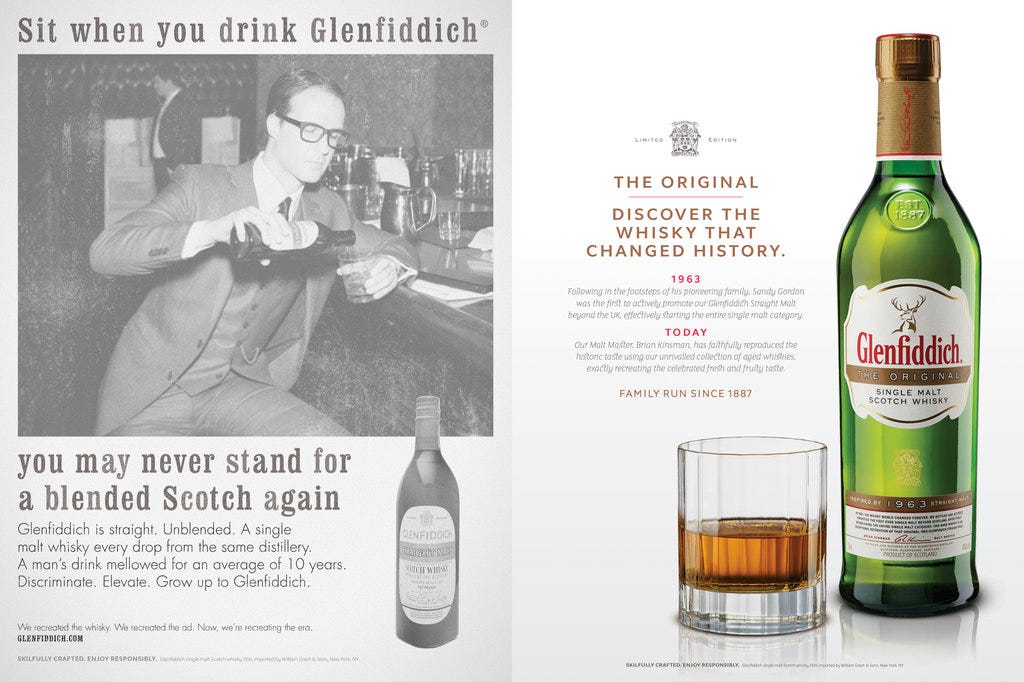Whisky is for everyone (as long as you have enough money)
Is it a wise move for Scotch whisky companies to remove the aura of reverence around their product while jacking up prices?
Way back in the 1990s I travelled up to Aberdeen for my uncle’s wedding with my girlfriend at the time. On the way back we stopped with some friends of my parents near the Borders where she horrified our hosts by professing a love of whisky and then when handed a glass of single malt, topping it up with Coca-Cola. It was like something out of a Bateman cartoon.
How times have changed. If you go on a distillery tour in Scotland these days, it will always begin with a mantra, rather like saying grace before a meal back in Christian times. It goes something like this: “whisky is for everyone”, and the follow-up is “there’s no right or wrong answers, and no right or wrong way to drink whisky.” Amen.
Now this might seem like good sense, after all why not try and aim your product at the largest possible audience, but there’s also an unspoken part to it: “don’t be like one of those whisky bores.” Sometimes it’s even made explicit like at the beginning of the tour of Johnnie Walker’s new brand home on Princes Street in Edinburgh with an image of a bearded man in a leather arm chair - he’s your whisky enemy.
The message is that the whisky snob, always male, always white, usually bearded, is getting in the way of whisky egalitarianism. This might be true to some extent, perhaps whisky’s masculine image does put some people off though it’s largely an image created by the whisky companies and one that they were pushing until very recently. As irritating as it is having whisky brands pretend that their latest campaign is some sort of blow for women’s rights, as Glenlivet’s latest does (see below), I accept that marketing has to move with the times and ignoring half the population is unwise (though it would be interesting to see how a Scotch whisky marketed today with leather armchairs, grouse moors, tweed and zero irony would fare). But even with the changing demographic of customers, the male whisky drinking stereotype still happens to be Scotch’s most loyal customer and it’s never a good idea to insult or take him for granted.
Imagine this fellow, let’s call him Angus. He’s been buying single malts since before they were fashionable, and has watched prices climb and climb. In the past, Scotch whisky and especially single malts were marketed on being ‘in the know’ - like in the Macallan ad below. They required a bit of investment from the customer, not just with the often difficult flavours but also those hard to pronounce Gaelic names. I still have to remind myself of the correct way to say Ledaig - it’s ‘lay chick.’ The whisky industry has spent decades getting customers to treat their single malts with reverence, and now they’re saying, “don’t be so stuffy, just stick some bloody Coke in it, you massive snob!” Very confusing for Angus and his ilk.
I should personally say that I’m not a whisky purist and have enjoyed cocktails like the Smoky Cokey, a blend of Coca-Cola and Lagavulin 16 year old, just as long as someone else is paying as Lagavulin now costs more than £80 a bottle. Now imagine poor old Angus, £80 might be well be 15% of his weekly wage. He’s not going to be amused by someone sticking fizzy drinks in his precious whisky. I’ve always wondered how far you could push the “there’s no right and wrong way to drink whisky.” Would the Diageo brand ambassadors keep smiling as I poured Lilt into my £3,000 a bottle Port Ellen? When a bottle represents a significant investment, suddenly “drink it anyway you like, don’t be so stuffy” seems a bit insulting. Whisky is for everyone as long as you have enough money.
I think big whisky companies might be making a massive strategic error with the “drink it how you like” message. Many of the big single malt brands such as Glenlivet and Glenmorangie have gone big on cocktails. Some are nice but many could have easily been made with rum and I’m not sure I would have noticed the difference. Rather than being something that stands apart from other spirits, as champagne does with wine, by saying Scotch whisky can be drunk any way, it’s now in the same category as rum, tequila, bourbon, and brandy.
Ironically while Scotch whisky is trying to remove reverence for its product, other spirits are attempting the opposite. I was talking to a mezcal producer recently who encourages his customer to drink it neat to appreciate its complexity. When you mix it, you’re competing with tequila at £20 a bottle, he said, yet his mezcal costs £60. He was hoping that one day mezcal would have the kind of cache that single malt Scotch has.
It’s a very hard line to walk, preaching egalitarianism while putting up prices. Talisker 18 year old more than doubled in price this year. Angus might just keep coming back to single malt Scotch whisky, but there’s a lot of competition out there for people who want complex, aged spirits. If there’s one lesson to learn from the political turmoil of the last few years is that if you take your core customers for granted, they will go elsewhere. And it’s very hard to entice them back.







If Scottish whisky is under 6 years old, it’s fine to mix it, and thus pursue a volume led growth strategy. Anything north of 6 years old, however, requires proper pricing; the balance sheet would otherwise crush the P\L, destroying value. At Brown-Forman we agonised over Jack & Coke for decades. But our whiskey matures earlier (those TN summers explode the alcohol into that charred new American oak … you get 12 years of “Scottish” aging in 4-6 years, depending on the weather and warehouse), and we finally agreed that it would be best to recruit consumers into the franchise via a mix that they had authored themselves.
I think the move towards cocktails and mixing is largely a financial one. After all, these are large multinational conglomerates whose only interest is growth. The single malt market has largely come to its max, you can't really convince more people that single malt scotch is the best, everyone already "knows" that, regardless if they drink it. How many rums, mezcals, brandies etc.. have marketed themselves as being the single malt of the rum/mezcal/brandy world?
So where can large volume growth come from? Cocktails. If more bars put Scotch on their menus, they'll sell far more cases than they would simply neat. The vast majority of the industry has pivoted towards large scale yield and efficiency to match the continued growth of single malts during the 2000s & 2010s in Europe, N America and Asia.